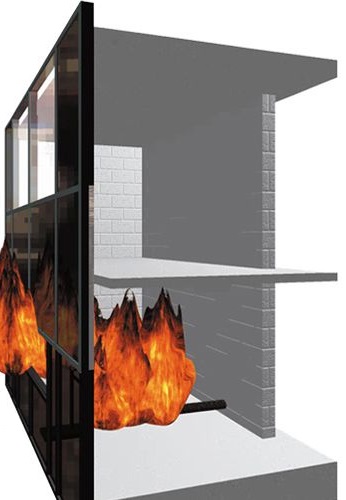What is Heat Resistant Concrete?
As its name indicates, heat resistant concrete is the material that can resist high temperatures. The fundamental material used for making heat resistant concrete is high alumina concrete or calcium aluminate concrete.
At the time when high alumina concrete goes through high temperatures, it will experience a little measure of extension yet it will be strong enough to bear the usual load.

Heat Resistant Concrete
The most utilized heat-resistant concrete is crushed aggregate with alumina concrete. Sometimes these aggregates can be called refractory aggregates. This material can withstand temperatures of up to 1400 degrees Celsius.
Higher temperatures ( above around 400 °C), heat-resistant concrete are commonly required. At the point when temperatures get extensively high, (above 550°C), calcium aluminate concrete should be utilized.
However, recently discovered that the addition of new unique cement can modify the concrete. Creating cement or mortar will deliver an unimaginable expansion in heat obstruction. Concrete mortars have been exposed to temperatures of 2000°C with no genuine harm. It is also known as refractory concrete.
Types of Heat Resistant Concrete (Refractory Concrete)
There are two types of Refractory concrete as follows:-
- High-grade heat resistant concrete
- Low-grade heat resistant concrete
High-Grade Heat Resistant Concrete
The 1st-type of high-grade heat resistant concrete can oppose high temperature or it can oppose high temperature against the hot faces. Heat resistant concrete can be utilized for hot faces instruments. Hot-face instruments are any material that is under the immediate attack of warm origin.
Ex:- Gas burner, Woodfire, etc.
Low-Grade Heat Resistant Concrete
The 2-type of heat resistant concrete resists low-grade heat. It can be used for low heat resistant.
Also Read: Planning and Site Preparation for concrete
Properties of Heat Resistant Concrete
Normally, heat-resistant concrete displays break after first terminating. These breaks are because of drying-out shrinkage and chemical reactions between the concrete and aggregate at high temperatures. In some conditions, these breaks will get filled when concrete is reheated to its serviceable temperature because of thermal expansion.

Application of Heat Resistant Concrete
Generally, it is used in runway asphalts or runway pavements. Concrete pavement is presented to high temperatures from a wet airplane. At the point when suddenly heat is applied, steam inside the substance can cause spalling. The concrete pavement is damaged by the high temperature of jet blasts including sampling aggregate popouts, fissures, and cracks.
Advantages of Heat Resistant Concrete
- Shrinkage: The refractory concrete doesn’t twist during drying and firing as it will get set by chemical reaction, which is why they were sintered to make a clay bond.
- Green strength: The refractory concrete has a similar strength to the convertible concrete even before it has been terminated. It tends to move more effectively than large fragile clay or mud pieces
- Toughness: When fired, the refractory concrete is considerably harder than the traditional concrete because of the aggregate’s ability to capture break propagation.
Disadvantages of Heat Resistant Concrete
- Heat resistant concrete may harm the environment as well as human beings.
- The heat resistant particles are harmful to the human body.
- The heat resistant concrete has good integrity and airtightness that’s why it harms our livelihood.
What are the Ingredients Used to Make Heat Resistant Concrete?
- Refractory aggregate (Crush sand from the river)
- Refractory cement ( Calcium aluminate cement)
- Water
- Lime (CaO)
What is Refractory Cement?
Any extent of combination, for example, fireclay-silica-ganister blend or fireclay blended in with crushed brick or fireclay–silica sand is known as Refractory cement.

Refractory Concrete
In Refractory concrete, a mass refractory grain mass is at first reinforced with a fired bond, which is fired with the chemical reaction of Si3N4 and Si2ON2 which secures an extensively high temperature sintered concrete from the impact of disintegration at the time of utilizing the concrete as a liner for heater dividers, box.
Also Read: What are the different varieties of cement
Composition of Refractory Cement
- Aluminous Materials (mainly Al2O3)
- Calcareous Materials
- Magnesium Chloride/Calcium Chloride/Barium
- A mixture of binder or clinker and coarse aggregate
- Chloride/Sodium Chloride
- Alumina ceramics, fire clay, bricks, precast shapes, aluminate cement
- Asbestos, Burned spinel
- Magnesia, Reactive magnesia
- Organic acid
For the manufacturing of the refractory cement from the above materials, the calcination process is done at a temperature that ranges from 1500 to 1550 Celsius.
Use of Refractory Cement
The refractory cement is used in different places:
- In chimneys and Wood consuming ovens where the temperature is extremely high, refractory cement can be utilized.
- Refractory cement is a decent material to fix Furnaces and Incinerators.
- At the hour of Setting and holding firebrick in firebox chambers, it is used.
- Electrical or warm protection. For giving thermal insulation from the heat it can do a superior job.
- To seal air and gas leaks, refractory cement is used.
How to make heat resistant concrete?
Fire-resistant refers to a material’s ability to stand or bear the extensively high heat or temperature. At such high temperatures, several materials lose their strength, and stiffness and spalling occur. However, concrete is a protective material.
Different constituent components used to prepare concrete, including clay, limestone, gypsum, and aggregate, make the material impervious to heat and flames. The composition itself makes concrete non-combustible while being chemically inert so no additional fire-protection is required.
The slow rate of the heat movement permits concrete to withstand extensively high temperature without breaks, cracks, emitting toxic gases, smoke, or molten particles.
Discussing its fire-resistant quality, concrete maintains its Structural ability, and the material doesn’t burn itself. This limits the risk of fire while requiring the least maintenance to prevent itself from damage.
What kind of cement is heat resistant concrete?
Refractory cement is the kind of heat resistant concrete.


Leave a comment